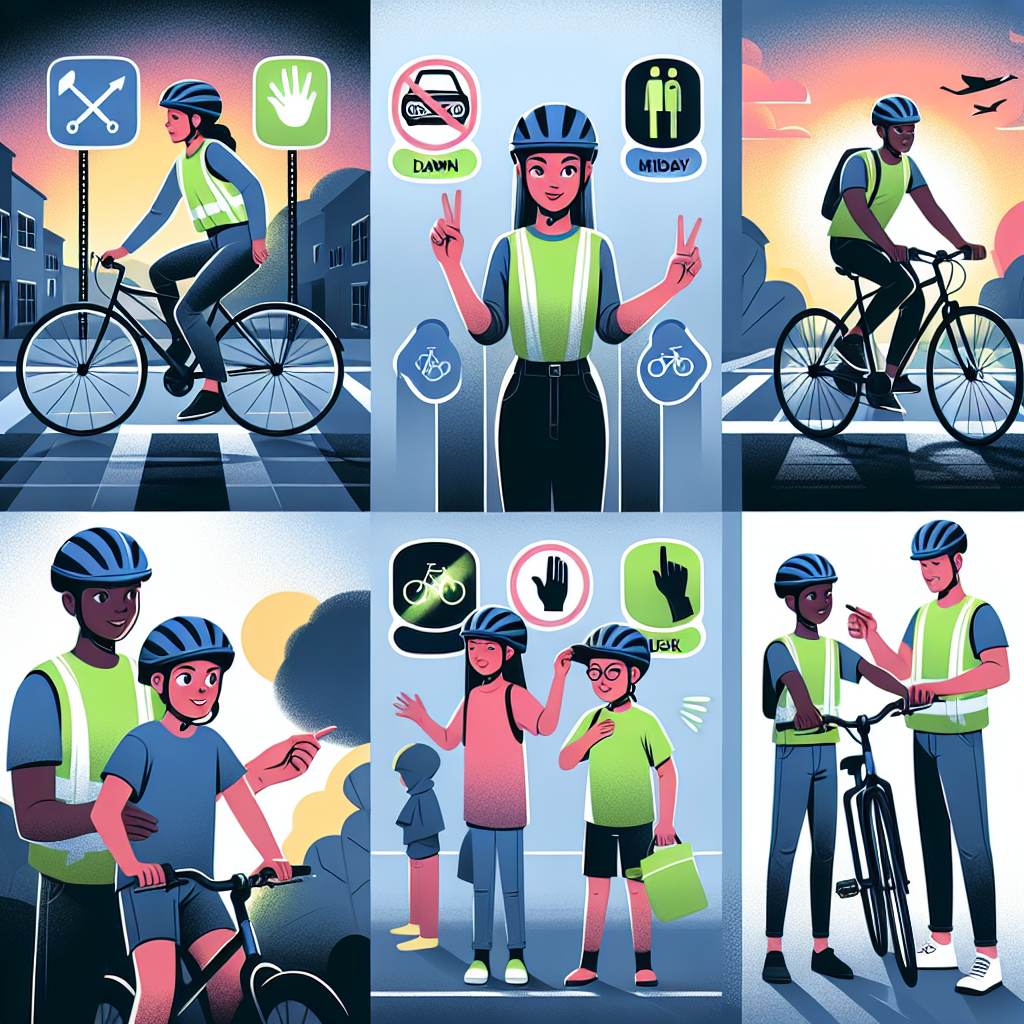Are you a biking enthusiast looking to hit the road with confidence and safety? Look no further! This article brings you 10 essential tips for biking safety that will ensure a smooth and worry-free ride. From wearing a helmet to obeying traffic rules, these tips cover everything you need to know to stay safe while enjoying your biking adventures. So gear up, hop on your bike, and let’s dive into these invaluable tips that will make your biking experience both enjoyable and secure.
Choose the Right Bike
Consider Your Riding Style
When it comes to choosing the right bike, it’s important to consider your riding style. Are you planning to ride off-road trails, cruise on paved roads, or use your bike for commuting? Different types of bikes are designed for specific purposes. For example, mountain bikes are built for off-road adventures with their rugged frames and knobby tires, while road bikes are designed for speed and efficiency on paved surfaces. By identifying your riding style, you can narrow down your bike options and find one that suits your needs.
Determine the Right Bike Size
Finding the right bike size is crucial for your comfort and safety while riding. A bike that is too small or too big can lead to discomfort, poor control, and even injuries. To determine the right bike size for you, consider your height, leg inseam, and reach. Most bike manufacturers provide size charts that correlate these measurements to the appropriate bike frame size. It’s also recommended to visit a local bike shop where experts can help you find the perfect fit by adjusting the seat height, handlebar position, and overall bike geometry.
Check for Proper Fit
Once you’ve determined the right bike size, it is essential to check for proper fit. Adjustments can be made to the bike’s components to ensure a comfortable riding position. Start by adjusting the seat height, making sure your leg is slightly bent at the bottom of the pedal stroke. Next, check the handlebar position. You should be able to reach the handlebars comfortably without straining your back or shoulders. Additionally, ensure that the bike’s frame geometry allows for a balanced and stable riding position. A proper fit will not only enhance your riding experience but also prevent the risk of discomfort or injuries.
Ensure the Bike is in Good Condition
Before hitting the road, it’s important to inspect your bike and ensure that it’s in good condition. Regular maintenance and check-ups can help identify any potential issues and prevent accidents. Start by examining the frame for any cracks or signs of damage. Check the brakes to ensure they are working properly and the brake pads are not worn out. Inspect the tires for any punctures or excessive wear, and make sure they are properly inflated. Finally, check the chain, gears, and drivetrain for any signs of rust or malfunction. If you are unsure about the condition of your bike, it’s best to consult a professional bike mechanic for a thorough inspection.
Wear Appropriate Safety Gear
Always Wear a Helmet
One of the most important safety precautions for cyclists is wearing a helmet. In the event of a fall or collision, a helmet can protect your head and reduce the risk of severe head injuries. When choosing a helmet, make sure it fits snugly on your head and covers your forehead and temples. It should also have adjustable straps to ensure a secure fit. Remember, wearing a helmet should be a non-negotiable habit every time you hop on your bike, regardless of the distance or terrain.
Use Reflective Clothing
To enhance your visibility to others on the road, consider wearing reflective clothing. Reflective materials reflect light, making you more noticeable to drivers, especially in low-light conditions or at night. Reflective vests, jackets, or even small accessories like reflective arm or leg bands can greatly improve your visibility and reduce the risk of accidents. Additionally, choosing brightly colored clothing can also help increase your visibility during the day. By being easily seen by others, you can significantly improve your safety while biking.
Wear Proper Footwear
Having the right footwear is important for both comfort and control while biking. Opt for closed-toe shoes with a firm grip on the pedals. Athletic shoes or cycling-specific shoes with stiff soles are ideal, as they provide stability and power transfer. Avoid wearing sandals, flip-flops, or any footwear that exposes your feet. Proper footwear not only ensures a secure connection to the pedals but also protects your feet from potential injuries or accidents.
Consider Using Protective Eyewear
While not mandatory for all bicyclists, wearing protective eyewear can be beneficial, especially when riding at high speeds or in windy conditions. Cycling glasses or sunglasses with UV protection not only shield your eyes from harmful sun rays but also prevent debris, insects, or dust from impairing your vision. In addition, wearing eyewear can protect your eyes from wind, preventing discomfort or tears that can distract you from the road ahead. Prioritize your safety by considering protective eyewear as part of your biking gear.

Be Visible to Others
Use Bike Lights
To increase your visibility, especially when riding at dawn, dusk, or during nighttime, it is essential to use bike lights. Install a white light on the front of your bike and a red light at the rear. These lights will help others, including pedestrians, cyclists, and motorists, see you from a distance. Additionally, consider using lights with different blinking patterns or additional reflective elements to attract more attention. Remember to check your lights regularly to ensure they are functioning properly and replace batteries or recharge them as needed.
Wear Bright or Reflective Clothing
In addition to using bike lights, wearing bright or reflective clothing can significantly improve your visibility. Choose clothing in fluorescent colors that stand out against the surroundings. These vibrant colors are more noticeable to others, even in low-light conditions. Pairing bright clothing with reflective accessories, such as reflective bands or tape on your helmet, bike frame, or even your shoes, can further enhance your visibility. By ensuring you are easily seen by others, you reduce the risk of accidents and create a safer riding environment.
Signal Your Intentions Clearly
When riding on the road, it’s important to communicate your intentions to other road users. Use proper hand signals to indicate your turns, lane changes, or stops. Extend your left arm straight out to indicate a left turn, bend your left arm at a 90-degree angle upwards to indicate a right turn, and bend your left arm at a 90-degree angle downwards to indicate a stop or decrease in speed. Signaling your intentions clearly allows other road users to anticipate your actions, ensuring a smoother and safer flow of traffic.
Choose Well-Lit Routes
When planning your biking routes, opt for well-lit areas, especially during nighttime rides. Well-lit routes provide better visibility for you and make it easier for others to see you. Choose routes that have streetlights or are well-lit by surrounding businesses or residential areas. Avoid dimly lit roads or areas with poor visibility as they can increase the risk of accidents. By selecting well-lit routes, you can ensure a safer and more enjoyable biking experience.
Follow Traffic Laws
Obey Traffic Signals and Signs
As a cyclist, you share the road with other vehicles, making it important to obey traffic signals and signs just like any other road user. Stop at red lights, yield at yield signs, and follow the traffic flow at intersections. Adhering to traffic laws not only ensures your safety but also promotes respect and predictability on the road. By setting a good example and being a responsible cyclist, you contribute to a safer road environment for everyone.
Ride in the Same Direction as Traffic
When riding on the road, it’s important to ride in the same direction as traffic. Riding against the flow of traffic is not only illegal but also increases the risk of collisions. When you ride with the flow of traffic, drivers can anticipate your movements and adjust their actions accordingly. If the road has a designated bike lane, use it properly and ride in the same direction. By following this basic rule, you minimize the chances of accidents and conflicts with other road users.
Use Hand Signals
As mentioned earlier, using hand signals is crucial for communicating your intentions while riding. Hand signals not only inform other road users of your upcoming turns or stops but also help you maintain stability and control. Practice using hand signals until they become second nature, and remember to hold your line and maintain balance while signaling. By using hand signals effectively, you enhance your safety and promote clear communication with others on the road.
Yield to Pedestrians
Respecting pedestrians’ rights and safety is essential as a cyclist. Always yield to pedestrians, especially when crossing crosswalks or sharing paths with walkers. Slow down, give pedestrians the right of way, and be considerate by providing ample space when passing them. When in doubt, err on the side of caution and prioritize pedestrian safety. By practicing this courtesy, you foster a positive relationship between cyclists and pedestrians and create a safer environment for all.

Stay Alert and Be Mindful
Pay Attention to Surroundings
Being alert and aware of your surroundings is crucial for your safety on the road. keep a lookout for vehicles, pedestrians, and other potential hazards like potholes or debris. Scan the road ahead, check your mirrors, and be mindful of any blind spots. By staying vigilant, you can react timely to changing situations and make informed decisions while riding.
Avoid Distractions
To ensure your full attention is devoted to the road, avoid distractions while biking. Put away your phone, turn off music, and focus solely on the task at hand. Distractions can impair your judgment, slow your reaction time, and compromise your overall safety. Stay present and engaged, allowing you to navigate the road with ease.
Use Mirrors or Shoulder Checks
A useful technique for staying aware of your surroundings is using mirrors or shoulder checks. Mirrors attached to your bike or helmet can provide a rear view and allow you to monitor approaching vehicles without having to turn your head. Shoulder checks, on the other hand, involve physically looking over your shoulder to check blind spots and ensure there are no vehicles or obstacles around you. Incorporating these habits into your riding routine keeps you informed and minimizes any surprises on the road.
Be Prepared for Unexpected Situations
While biking, it’s important to be prepared for unexpected situations. Stay mentally and physically ready to react to any sudden changes, such as a car door opening, a pedestrian stepping off the curb, or a sudden shift in traffic patterns. Anticipate potential hazards and react accordingly by adjusting your speed or position on the road. By staying alert and prepared, you can navigate through unexpected situations safely and confidently.
Ride Predictably
Maintain a Steady Speed
Maintaining a steady speed while biking promotes predictability on the road. Avoid sudden bursts of speed or unnecessary slowing down, as it can confuse other road users. Find a comfortable pace for your biking style and strive to maintain it consistently. By riding predictably, you allow others to anticipate your movements, reducing the risk of accidents caused by sudden changes in speed.
Stay in a Straight Line
As a cyclist, it’s important to ride in a straight line whenever possible. Swerving or erratic movements can startle other road users and increase the chances of collisions. Keep a steady course and avoid unnecessary weaving between lanes or obstacles. If you need to change lanes or make a turn, signal clearly, check your blind spots, and merge smoothly. By riding in a straight line, you establish yourself as a confident and predictable road user.
Avoid Sudden Maneuvers
When biking, sudden maneuvers can surprise other road users and increase the risk of accidents. Avoid abrupt turns, lane changes, or stops whenever possible. Instead, plan your movements in advance, signal your intentions, and execute them with smoothness and predictability. By minimizing sudden maneuvers, you create a safer riding environment for yourself and others.
Signal Early and Clearly
To ensure others on the road understand your intentions, it’s crucial to signal your turns, stops, or lane changes early and clearly. Give other road users ample time to react and adjust their actions accordingly. Signal with confidence and hold your signals until the maneuver is complete. Clear and timely signaling promotes better communication and avoids confusion, enhancing overall road safety.

Stay in Control
Maintain Proper Braking Technique
Knowing how to brake properly is essential for maintaining control while biking. Use both brakes simultaneously, applying firm but gradual pressure to slow down or stop. Avoid using only your front brake, as it can cause you to go over the handlebars. Practice braking in different conditions to get familiar with your bike’s braking capabilities and adjust your technique accordingly. By maintaining proper braking technique, you can maximize control and minimize the risk of accidents.
Control Your Speed
Controlling your speed is crucial for your safety, especially when biking downhill or in congested areas. Adjust your speed according to the road conditions, traffic flow, and your own comfort level. Slow down when approaching intersections or crowded areas and be mindful of your surroundings. By maintaining a safe and controlled speed, you can navigate the road with confidence and respond effectively to any situation that arises.
Watch for Road Hazards
While biking, it’s important to stay vigilant and watch for potential road hazards. Keep an eye out for potholes, cracks, loose gravel, debris, or any other obstacles that may pose a threat. When encountering such hazards, prepare yourself by slightly lifting your weight off the seat and holding the handlebars firmly. Avoid sudden swerving or braking, as it may lead to loss of control. By staying aware of road hazards, you can navigate them safely and minimize the risk of accidents.
Use Both Hands on the Handlebars
Maintaining control of your bike requires both hands on the handlebars. Avoid riding with one hand or no hands whenever possible, as it compromises your stability and maneuverability. Keep a firm grip on the handlebars, allowing for better control and the ability to react quickly if needed. By using both hands on the handlebars, you ensure maximum control over your bike and reduce the risk of accidents caused by loss of control.
Use Bike Lanes and Paths
Stick to Designated Bike Lanes
Whenever available, it’s important to utilize designated bike lanes. Bike lanes provide a dedicated space for cyclists, separating them from vehicular traffic and increasing their safety. Stay within the bike lane whenever possible and avoid veering into vehicle lanes unless necessary. Riding in designated bike lanes not only reduces conflicts with motorists but also promotes a smoother flow of traffic for everyone.
Use Multi-Use Paths or Trails
In addition to bike lanes, multi-use paths or trails are great options for cyclists. These paths are designed for shared use by pedestrians, cyclists, and sometimes even rollerbladers or skateboarders. When using multi-use paths, be aware of other users and maintain a safe speed, especially when passing pedestrians. Communicate your presence with a bell or a friendly verbal warning as you approach others. By using multi-use paths responsibly, you can enjoy a safe and enjoyable biking experience while respecting other trail users.
Ride Single File in Groups
When riding in a group, it’s important to ride single file, especially on roadways. Riding in a single file formation reduces the space your group occupies on the road and allows other vehicles to pass more easily. This promotes a smoother flow of traffic and minimizes the risk of accidents caused by vehicles trying to navigate around a wide group. By riding single file, you prioritize safety and cooperation with other road users.
Be Cautious Near Parked Cars
When biking near parked cars, exercise caution to avoid potential doorings or unexpected movements from drivers. Stay a safe distance away from parked cars, ideally at least three feet. This gives you enough space to react if a door suddenly opens or a driver begins to exit their vehicle. Keep a lookout for signs of activity inside parked cars, such as brake lights or people sitting in the driver’s seat, as these can indicate potential door openings. By being cautious and maintaining a safe distance from parked cars, you can minimize the risk of accidents or collisions.

Be Aware of Weather Conditions
Adjust Your Riding Style for Rain or Snow
When riding in rainy or snowy conditions, it’s important to adjust your riding style to account for the reduced traction and visibility. Slow down, be gentle with your braking and steering inputs, and give yourself extra stopping distance. Avoid sharp turns or sudden maneuvers that may cause your tires to lose traction. Consider using fenders to reduce water or snow splashes, and wear appropriate rain or snow gear to keep yourself dry and comfortable. By adapting your riding style to the weather conditions, you can maintain control and ride safely.
Avoid Riding During Strong Winds
Strong winds can significantly affect your stability and control while biking. Avoid riding during periods of high winds, especially during severe weather conditions. If you find yourself caught in gusty winds, grip your handlebars firmly and adjust your body position to remain stable. When riding with crosswinds, lean into the wind to counterbalance its effect and prevent sudden movements. By avoiding riding during strong winds, you reduce the risk of accidents or loss of control.
Beware of Slippery Surfaces
Rain, snow, or frost can create slippery surfaces that increase the chances of accidents. Be cautious when riding over wet leaves, painted lines, metal grates, or other potentially slippery surfaces. Reduce your speed and use gentle braking and steering inputs to maintain traction. Avoid sudden accelerations or decelerations, as these can cause your wheels to lose traction. By staying aware of slippery surfaces, you can adjust your riding technique and prevent accidents caused by loss of traction.
Dress Appropriately for the Temperature
When biking in different weather conditions, it’s important to dress appropriately to stay comfortable and safe. Layer your clothing in cold temperatures, ensuring you have enough insulation without overheating. In hot weather, opt for lightweight, breathable fabrics that wick away moisture. Consider wearing gloves to protect your hands from cold or windy conditions, and wear sunscreen to protect yourself from harmful UV rays. By dressing appropriately for the temperature, you enhance your comfort and reduce the risk of weather-related health issues.
Educate Yourself
Take Bike Safety Courses
Taking bike safety courses can greatly enhance your knowledge and skills as a cyclist. These courses cover topics such as bike handling, traffic rules, and crash-avoidance techniques. You can learn from experienced instructors who provide valuable insights and hands-on training. Many cities and organizations offer bike safety courses, so take advantage of these opportunities to become a more confident and skilled rider. By continually educating yourself, you can stay informed about the latest best practices and improve your biking safety.
Learn Basic Bike Maintenance
Having basic knowledge of bike maintenance can save you from potential breakdowns or accidents caused by mechanical failures. Learn how to fix a flat tire, adjust your brakes, and lubricate your chain. Regularly inspect your bike for wear and tear, and keep it clean and properly lubricated. Understanding your bike’s components and their maintenance requirements empowers you to keep your bike in optimal condition, ensuring its reliability and safety on the road.
Stay Updated on Local Bike Laws
Just as motorists must be aware of traffic laws, cyclists must also familiarize themselves with local bike laws. These laws may vary from one jurisdiction to another, so it’s important to stay updated on the specific rules and regulations in your area. Learn about bike-specific traffic laws, such as helmet requirements, where bikes are allowed to ride, and any local ordinances that impact cyclists. By understanding and following the local bike laws, you not only ensure your safety but also promote a positive image of cyclists within the community.
Read Bike Safety Resources
There are numerous resources available that provide valuable information and tips on biking safety. Books, online articles, and government websites offer comprehensive guides on various aspects of biking safety, from equipment selection to road-sharing etiquette. Explore these resources to deepen your understanding of biking safety principles and incorporate them into your riding habits. By staying informed through reading, you can continuously improve your knowledge and make biking a safer activity for yourself and others.
In conclusion, biking can be a fun and enjoyable activity, but it’s essential to prioritize safety at all times. Choosing the right bike, wearing appropriate safety gear, being visible to others, following traffic laws, staying alert, riding predictably, staying in control, using bike lanes and paths, being aware of weather conditions, and educating yourself on biking safety are all integral parts of ensuring a safe biking experience. By incorporating these tips into your biking routine, you can help create a safer road environment for everyone and enjoy the many benefits that biking has to offer. So get out there, have fun, and ride safely!



